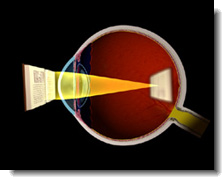
Nearsightedness or Myopia: What is it?
Symptoms You May Experience:
Examination: What Your Eye Doctor Will Look For:
What You Can Do:
When To Call Your M.D.:
Treatment:
Prognosis: Will I See Better?
Nearsightedness, or myopia, is the ability to see clearly up closebut not at a distance without glasses or contact lenses. The cause of nearsightedness is unknown but it tends to run in families. It is the most common type of vision problem in the United States, affecting more than 25% of the population.
Nearsightedness usually begins in childhood or early adolescence and progresses until the late teens or early twenties, when it stabilizes. Acquired nearsightedness is much less common and can be caused by many eye diseases which are discussed elsewhere on this site.
Nearsightedness usually begins in childhood or early adolescence and progresses until the late teens or early twenties, when it stabilizes. Acquired nearsightedness is much less common and can be caused by many eye diseases which are discussed elsewhere on this site.
Your vision is always blurred at a distance but clear when looking at things up close. A nearsighted child who is not wearing glasses or contact lenses may sit too close to the blackboard or television, squint frequently, or be unaware of distant objects.
You will be unable to read the eye chart at a distance during the exam. If tests indicate that glasses are likely to correct the problem, your eye doctor may then write a prescription for glasses or contact lenses.
There is no proven way to prevent nearsightedness. You should simply be aware of its symptoms so that if nearsightedness develops, you can be examined by an eye doctor.
Nearsightedness usually develops in children, so parents, teachers, etc. should be alert to the symptoms. A child who has difficulty seeing distant objects should see an eye doctor promptly to prevent the development of a lazy eye (amblyopia) and to exclude other causes of blurred vision.
Properly prescribed glasses and contact lenses can correct nearsightedness. Some people may benefit from refractive surgery (laser eye surgery). Annual eye exams are recommended, especially for those with high myopia, because nearsighted people can develop retinal tears and detatchments which they may not notice.

Anatomically there are two types of nearsightedness. In axial myopia the eyeball is elongated rather than spherical. Therefore, light rays entering the eye focus in front of the retina instead of right on it. In refractive myopia the refractive power of the cornea or lens is too strong, causing the same effect. Occasionally a person may be so nearsighted that he or she is at risk for developing other eye diseases. This condition is called high myopia and is defined as a refractive error of more than -6.00 to -8.00 diopters. A high myope may have a higher risk of retinal detachment, choroidal neovascularization, or glaucoma.
Contact Lenses | Glaucoma | Just For Fun | Eyeglasses | Eye Doctor | Eye Care And Symptoms | Eye Anatomy | Online Eye Tests | Laser Eye Surgery | Laser Eye Surgery Directory: Canada | Laser Eye Surgery Directory: USA | Laser Eye Surgery Reviews | Submit A Review | Contact Us | Privacy Policy | Sitemap
Copyright 2006-2009 Vision Health

